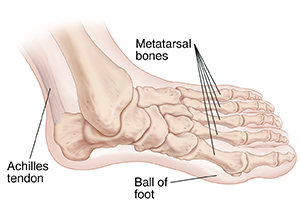Metatarsalgia is pain in the ball of your foot. It's often caused by wearing shoes with thin soles and high heels. This puts extra pressure on the bones in the ball of the foot. Standing or walking on a hard surface for long periods also puts added pressure on the bones. This causes pain. The pain can occur under any of the five metatarsal bones. It's most common in the second. Bent or twisted toes and bunions can make the problem worse. So can being overweight. A tight Achilles tendon can make the problem worse. Sometimes high arches or arthritis can also cause metatarsalgia.
Inside the ball of your foot
The long bones in the middle of your foot are called the metatarsal bones. Each metatarsal bone ends in the ball of the foot. These bones bear the weight of your body as your foot pushes off the ground when you walk. If there is more pressure on the end of one bone, it presses on the skin beneath it. This causes pain and inflammation in the ball of the foot (metatarsalgia). A hard growth of skin (callus) may also form on the ball of the foot.
Symptoms
The most common symptom of metatarsalgia is pain in the ball of the foot. It may feel as if you have a stone in your shoe. The ball of the foot may also become red and inflamed. A callus may also form under the end of the metatarsal bone.


